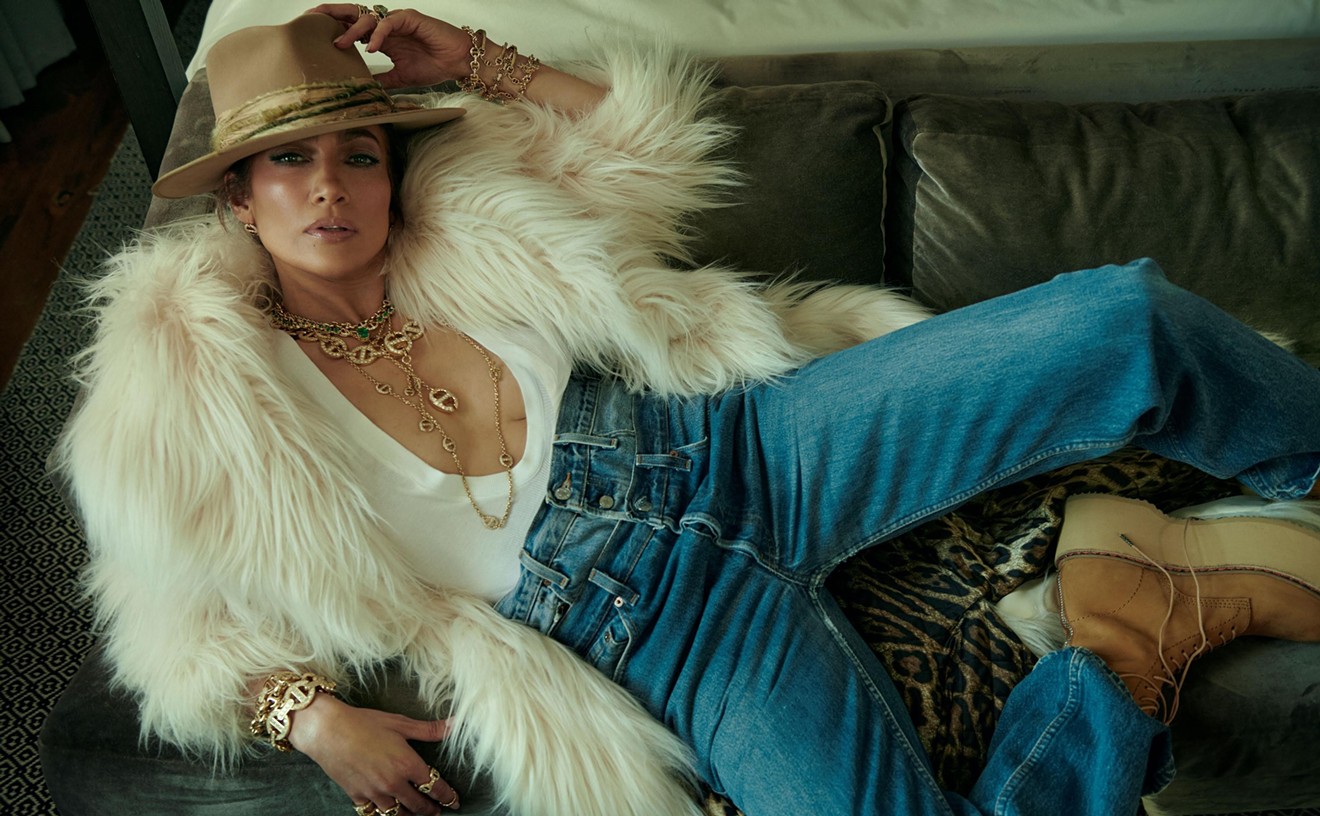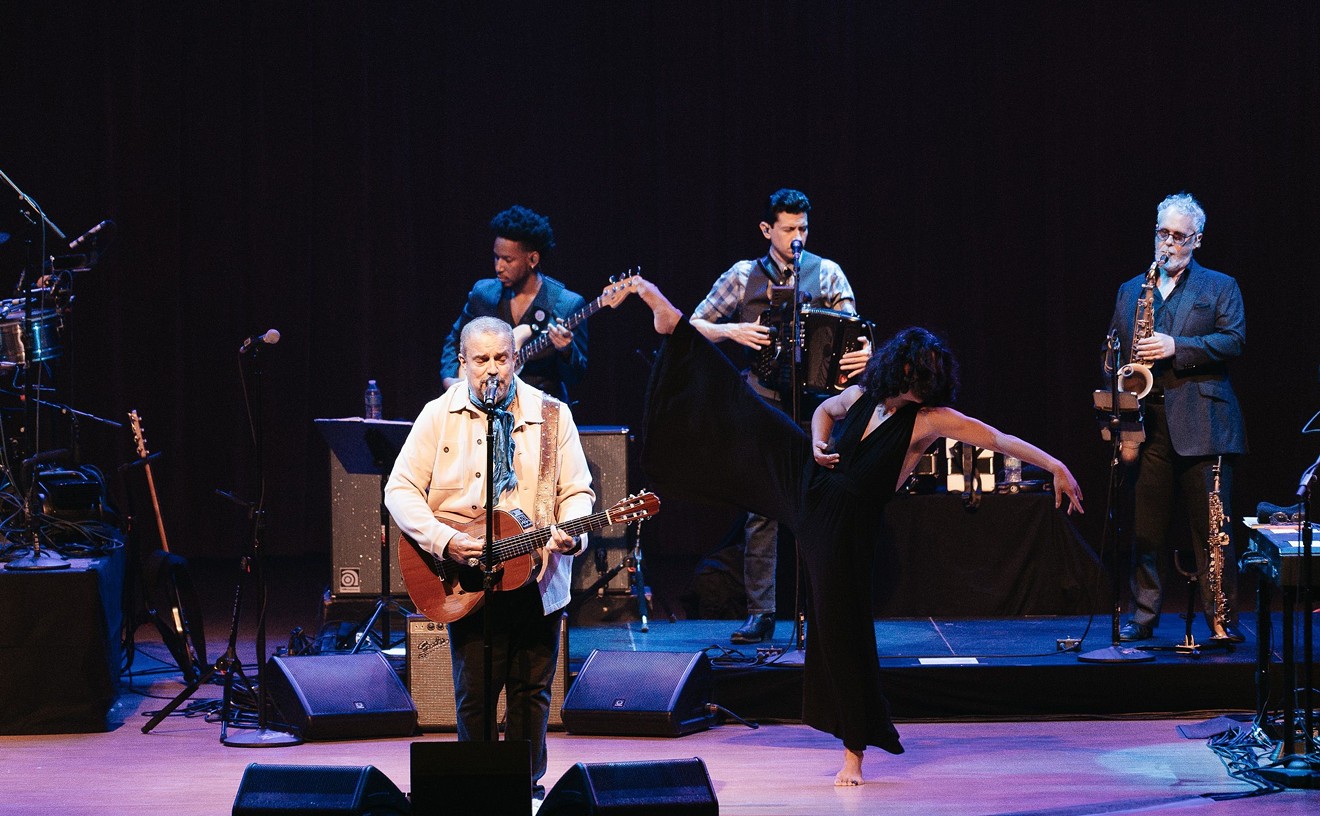"Who Am I to You?" It's a very generous question for an artist to ask an audience. Not enough artists present this self-reflective inquiry. The ultimate value of art is not monetary, but what it offers in terms of in its experiential value.
Organized by the Museum of Art Fort Lauderdale and curated by Freddy Jouwayed, South Florida can be proud of the 14 artists who were awarded a South Florida Cultural Consortium Visual and Media Artists Fellowship. Their resulting work is now in a truly memorable exhibition that runs through September 1.
The musical elements were displayed with the A S T R [ E L ] V E R A N D A installation at the close of the evening, a 3PQ collaboration, which includes artists Freddy Jouwayed, Sinisa Kukec, and Stephan Tugrul. They brought up Miami's finest music-makers, metal duo Holly Hunt and electronic dance master Panic Bomber, to perform as part of the art.
A rather indulgent but breathtaking piece marked the entrance to the exhibit. Leah Brown's 17-foot tall mixed-media sculpture "Weird Sisters" looked like a dream made manifest. Three pale-faced, curvaceous women lay slumbering with soft faces in fetal positions under thin white sheets. It triangulates into a tower of soaring, heaven-bound hair and bed sheets. At the top, a trio of half-human, half-bestial creatures burst from the fabric and lock arms in a dance. The curvaceous nude female forms were topped alternately with the heads of a deer, bear and a mountain lion, eyes wide and alive, representing that irrepressible primitive thing that exists in all of humanity.
"Weird Sisters" stands more as a statement than a subjective, interpretive piece, but it clearly was a highlight of the night for many. It is audacious and surreal with an undeniable presence.
Standing in rather unnoticeable juxtaposition behind the sculpture was a wall painted in blackboard paint. Wooden trays for holding chalk, also in blackboard paint, ran the length of the wall. Several pieces of white, somewhat porous chalk lay in random spots. Titled "Equator," using the medium of "map dust," artist Agustina Woodgate explained she had made the chalk from dust she had created from hand-sanding a pull-down map that once hung in a classroom. As impressive as her solo exhibit "New Landscapes" was at last year's Art Basel, here was another step in the work I had once thought of as a rather final end point.
Woodgate created "New Landscapes" over the course of several months, with hours upon hours of hand sanding. She obliterated maps in a giant Atlas and off of a globe. This resulted in piles of colorful dust and the bare skeletal remains of the original objects. I interpreted it as a metaphor for our true fate. No matter the books, the history, the maps, it all turns to dust in the end.
With "Equator," the artist pushed an already brilliant project to a new height. I felt the compulsion to use the chalk on the board and draw a map of Florida. Woodgate only wryly smiled and shrugged. I placed the chalk to the board and drew a line and a security guard ran up. "Don't do that!" I replied, "But the artist..." motioning to Woodgate with the chalk who nodded in approval, and I carried on. My meek little Florida map returned from map dust with a Lake Okeechobee dot and little dashes trailing at the bottom representing the Keys. Turning around, two other patrons were already busily marking up the wall with their own work. Though, indeed, the board may be wiped clean, the introduction of regeneration into her prior creations added another dimension to Woodgate's delightful body of work.
These were already some grand highlights for the exhibit, but there was so much more in the rooms that lay ahead.
One of the more impressive is an untitled performance piece by Catalina Jaramillo. She plans to spend 90 days at the museum, sitting at a desk tearing up 58 personal journals she began keeping in 1997.
It's far more than a stunt. It's a living allegory, presenting the idea that for one to live one must die. Like Woodgate's work, a rebirth is happening here, albeit a more intimate one. Though a sign discourages anyone from talking to the artist, no one stops you from looking over Jarmillo's shoulder and peering in at the work of her old self -- for as long as it might last. This is transformation in storied, real form. The scraps, she says in a statement, will be given to the museum to do with it what it will with them.
Another highlight worth noting was a huge screen showing Naomi Fisher's epic short film Vizcaya along with other elements of her 2011 exhibition from inside Vizcaya Museum and Gardens in Miami. It marked the first time Fisher has displayed elements of her "Vizcaya" installation outside its original setting. Her primitivist panels lose some context outside the decadent rooms of Vizcaya, but her short film of young women let loose on the grounds to swim, canoe and have a food fight at the historic mansion looked stunning on the giant screen.
What's so terrific about most of these artists is how they capture and celebrate experience over a product. It's almost as if they are thumbing their nose and the bourgeois idea of art-collecting, and instead, bringing art to everyone wiling to open themselves up to self-examination in the context of their concepts. It's work that invites the spectator rather than creates a divide.
The evening ended with the electronic sounds of Miami's Panic Bomber, aka Richard Haig, and the stripped down sludge of Holly Hunt; a creative, inspired pairing that fit the night nicely. Panic Bomber played with samples and remixed bits of music against a refracting wall of rainbows created from bright light projected on sheets of silver diffraction grating film, another work by Woodgate created especially for the museum, called "1111."
As Panic Bomber shifted from a song with the refrain "we could be knockin' boots" to a mellow loop of ambient drone, a rumble of guitar noise came from a large box -- the 3PQ installation -- that seemed haphazardly wrapped in black cellophane and billowing smoke from its cracks.
As Holly Hunt began its droning and rumbling, shock and surprise appeared on the faces of those who did not know what they were in. Meanwhile, one of the many dudes dressed in black jeans and T-shirt raised his fists in the air. One fan standing nearby noted he likes to use this din to help loosen his bowels in the morning.
3PQ artist Freddy Jouwayed explained the reason for choosing these two acts. On Holly Hunt, he said, "Their sound is overpowering, it moves through you, it commands the environment to the point that, for the time you experience them playing, it becomes the environment." And of Panic Bomber, Jouwayed told us that Haig uses "a pop sound to deliver complex ideas. It's like using pop as a veil."
"Isn't this a weird night at the museum?" said one surprised lady. It was. Funny how life-affirming art can seem that way. Keep rattling that cage, South Florida artists.
Who Am I to You? runs through Sunday, Sept. 1, at Museum of Art | Fort Lauderdale, 1 E Las Olas Blvd Fort Lauderdale, FL 33301. (visit moafl.org for details)
Follow Hans Morgenstern on Twitter @indieethos.
Follow @CountyGrind











